Writing concise and actionable learning outcomes is an important first step in developing a strong program with outcomes that students can easily navigate and meet during their degree.
Mapping these Program Learning Outcomes (PLOs) provides the overview needed to ensures your curriculum meets the expectations set out for all Ontario university programs and that your courses provide the necessary pieces for meeting your Outcomes.
On this page, we outline how to map your Program Learning Outcomes (PLOs) to the Degree Expectations (DLEs), your program's curriculum, and to program assessment.
For help on writing your Program Learning Outcomes, visit our page on writing learning outcomes, which includes a PLO checklist.

Mapping PLOs to Degree Level Expectations
After writing your unique PLOs, you need to ensure they meet Ontario's Degree Level Expectations (DLEs).
These expectations are called Degree Level Expectations (DLEs).
All of our programs must meet these DLEs.
To ensure that our unique PLOs meet the DLEs, you can map them.
In a spreadsheet, like the sample we've provided below, identify how your PLOs meet the Degree Level Expectations (DLEs). Note that PLOs work best when they fit the DLEs like a puzzle rather than a checklist of completion.

This table can be found in our Resources section with a separate template for both undergrad and graduate programs.
The Degree Level Expectations are described in detail on the OUCQA website.
See next section for using these descriptions to map your PLOs more thoroughly.
After mapping your PLOs to Ontario's Degree Level Expectations (DLEs) (see above), demonstrate the details of how each PLO reflects the DLE using the descriptors provided by Quality Council.
Ontario Universities Council on Quality Assurance, or Quality Council, has described and defined each DLE for university programs across Ontario. These descriptions demonstrate the different elements of different degrees (Bachelor’s versus Honours or Master's versus Doctorate).
While your PLOs define the whole program, a more complex mapping in which you have pulled out different elements of these definitions will demonstrate the details and differences between your 90 credit degree and 120 credit degree or your Master's program and your Doctoral program. This more complex mapping is especially important when assessing your PLOs.
Start with a spreadsheet, like the simplistic one shown above, and rather than provide "Xs", identify the elements of the DLE description that best describe your PLO.
Some of the DLEs have long descriptions, so you can specify which elements of the description are met through your PLO. See the example below in which PLO1 reflects some elements of "Depth and breadth of knowledge" and "Application of knowledge" and all of "Awareness of limits of knowledge." The sample PLO2 mapping follows suit.
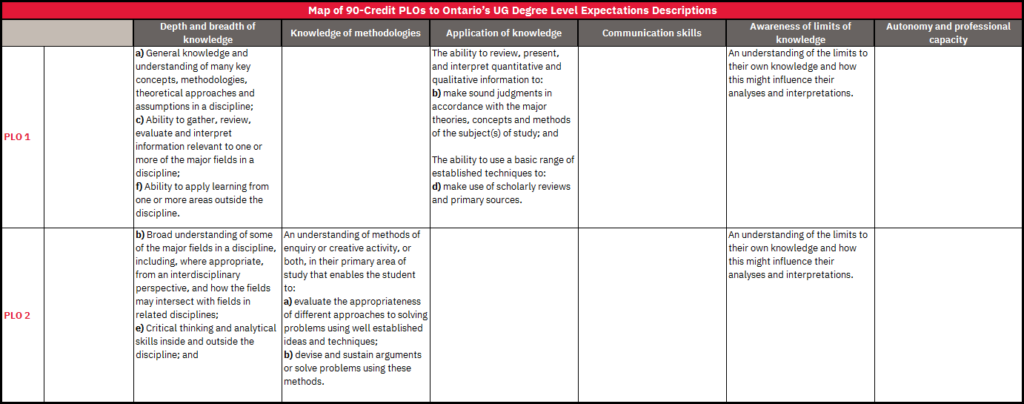
This table can be found in our Resources section with a separate template for both undergrad and graduate programs.
The Degree Level Expectations are described in detail on the OUCQA website.
This video can support mapping described above.
Mapping Program Courses and Assessments to PLOs (Curriculum Maps)
After establishing the connections your PLOs have to the DLEs, demonstrate how your courses meet the Program Learning Outcomes (PLOs).
List your PLOs and your courses - both core and elective - and identify which PLOs these courses meet. Your program courses should work in complement with one another so that, taken together, the courses represent the full completion of the Outcomes you have laid out for your program.
See below for a sample of a curriculum map.
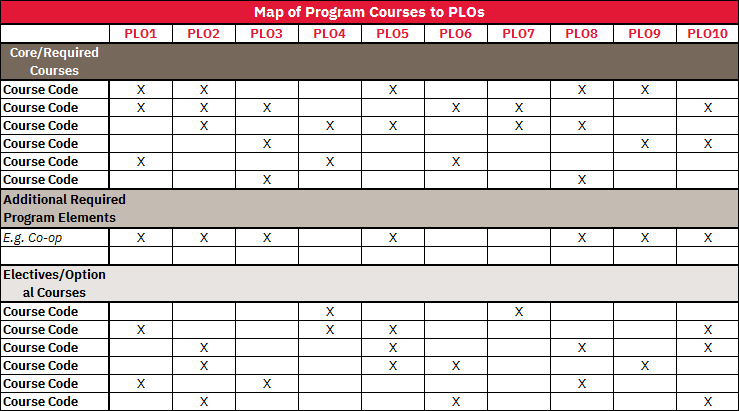
This table can be found in our Resources section with a separate template for both undergrad and graduate programs.
Some programs have a really extensive core/required set of courses with few electives. Other programs may have a small set of core/electives and many required courses. Some programs may have streams or clusters, while other programs have one foci all the way through. Your map will look as unique as your program. You can contact our support in the Office of the Vice Provost Academic, the Teaching Commons, and/or your faculty-level curriculum support to explore how to map the nuances in your program.
The key thing is to show that all students will meet all the PLOs no matter what courses they elect to take in their program.
How do you ensure that students are meeting the Program Learning Outcomes throughout their degree?
If students are taking the courses you've identified in the curriculum map (outlined above) then you can assume they are meeting the outcomes. But it is important we move away from assumption and toward documentation by mapping the assessments in the courses.
There can be different elements of program assessment, but one central element is articulating course assessments in a curriculum map. This mapping doesn't have to be be done for all courses, just the courses that ALL students or the majority of students have to take. This map needs to demonstrate that students are assessed on all the PLOs throughout the program.
In a table like the one below (which is a more complex version of the curriculum map provided above), you can identify assessment detail in three areas:
- Taught/Assessed: Were elements of this PLO taught and/or assessed in the course? Sometimes a PLO will be covered but not assessed. This is ok!
- Level of Coverage: Were elements of this PLOS taught/assessed in this course in an introductory level, a more developed level, or are students expected to master the outcome? The map below uses colour to demonstrate the times in which the PLO is introduced (yellow), developed (green), or mastered (blue). Tis could also be shown by numbers or letters, just ensure you have a key that explains your mapping system. In this sample map you can see that in some instances a PLO is taught in a more advanced way but assessed in a developing way. This is completely fine, as long as you're ensuring that PLOs are both taught and assessed at a mastery-level (or whatever you want to name the more advanced coverage) by the end of the students' program.
- Assessment-Type: If a PLO is assessed in a course, what is the assignment that will be used used for this assessment? An assignment may cover more than just one PLO and that multiple PLOs may be assessed in one assignment. This is fine! Course assignments primarily cover Course Learning Outcomes; just makes sure that they also are parts of the picture picture as articulated by the PLOs.

These videos can support mapping described above.
Course Learning Outcomes and PLOs
A professor should understand their course within the PLOs and the PLOs should reflect a professor's course(s).
If a professor is assigned a course, they should understand the objectives of this course is relation to the program: "I'm teaching ABCD 3003 and this course meets PLO2, PLO5, and PLO8. Therefore, I will organize my course to ensure that these elements are covered (and maybe assessed!) because of the ways this course fits into the overall program."
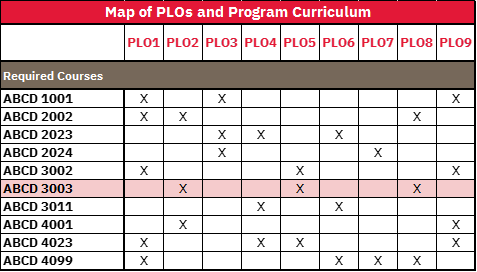

If a professor is designing a new course, they will have to identify how their course meets the PLOs in their course proposal. But having a concise and unique set of PLOs will make this exercise more authentic to the content of the course that is being proposed.
Note again, that a course doesn't have to, in fact shouldn't, meet all the PLOs. They should work in complement with other courses to make a well-rounded program for students.
A course should have their own Learning Outcomes that are SMART, demonstrate different levels of learning, actionable, multifaceted, and concise.
Courses and PLOs work best when there is a clear relationship between Course Learning Outcomes and Program Learning Outcomes.
A table such as this one can demonstrate the relationship between these Course LOs and PLOs.
In this sample, the professor has written five Learning Outcomes for their course.
Using the sample above, it was established in the program that this course meets PLO2, PLO5, and PLO8.
The professor then mapped their Course LOs to these PLOs.
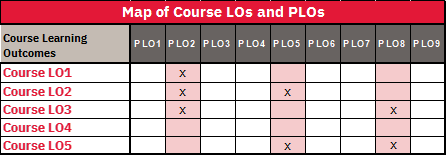
You can see that Course LO1 aligns with PLO2, Course LO2 aligns with PLO2 and PLO5. Course LO4 doesn't align with any of the PLOs though. This is ok! Given the individuality of courses and teaching, courses can do more than what is stated in the PLOs, but they shouldn't do less.
When we talk about program assessment, we often will talk about assignments in key courses. While this isn't the only way to assess whether students are meeting the Program Learning Outcomes, it is often a convenient way to track assessment in a program.
An effective way for professors to assist with the PLO assessment is to ensure that the assignments in their courses clearly map onto their Course Learning Outcomes and that their Course Learning Outcomes are clearly mapped onto their PLOs.
This way you extrapolate that, (drawing from the example below), if four assignments meet Course LO1, and Course LO1 aligns with PLO1, then how students do on those assignments (as a cohort) can assess whether they are meeting PLO1 as identified on a curriculum map.
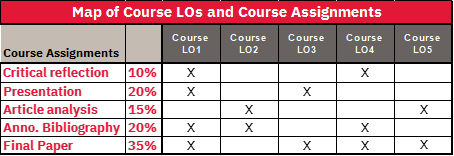
If the Course LOs have been mapped to PLOs, and assignments have been mapped to Course LOs, then it is easier to identify which individual course assignments can demonstrate program assessment.
Course assignments do not need to be designed to reflect PLOs. They should be designed to reflect Course LOs, but this method remains a good way to provide course-level detail/data on how students are progressing through the PLOs.

